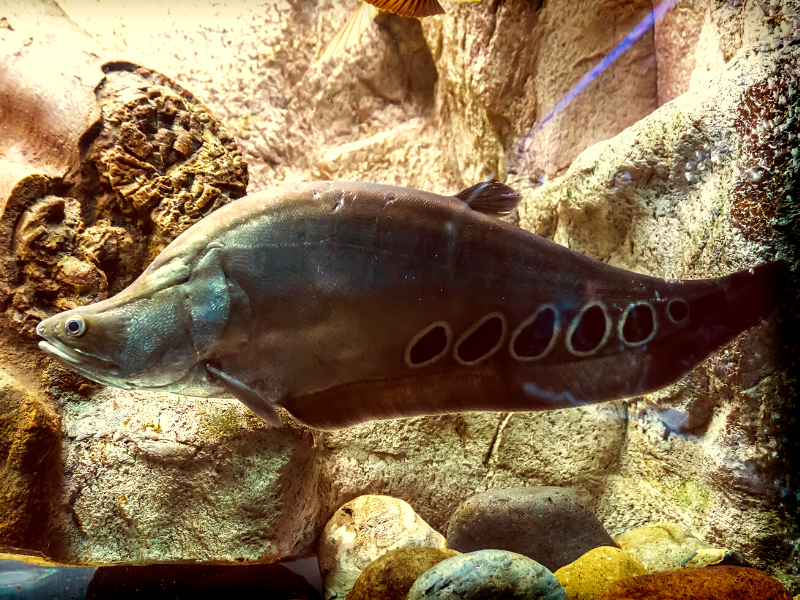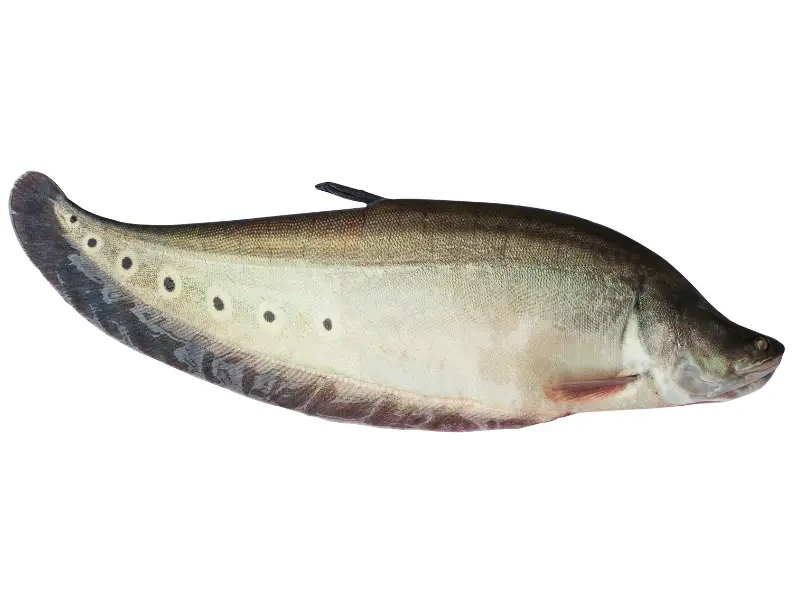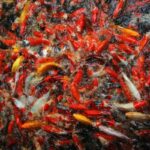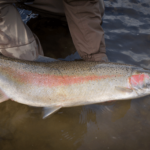Chitala Ornata, commonly known as the clown knifefish, is a nocturnal freshwater fish species that belongs to the Notopteridae family. It’s native to the tropical rivers of Vietnam, Cambodia, and Thailand.
Due to the distribution of aquarium fish, the reach of Chitala Ornata is no longer limited to the tropical regions of Southeast Asia. The species can now be found in many other regions of the world, including South Florida!

As one of the most unique-looking fish species out there, the clown knifefish has become remarkably sought-after, so much so that a lot of fishermen are actually obsessed with trying to catch one.
On that account, we decided to write an in-depth guide on how to catch clown knifefish. In this guide, we cover everything from the fish’s appearance and swimming habits to the best fishing tactics for catching one.
Let’s jump right into it!
All About the Clown Knife Fish
The clown knifefish, also known as the spotted knife fish or the clown featherback, has an elongated body with a humpback and a fairly long anal fin that almost looks like a knife, which is where the fish gets its name from.
The length of this fish’s anal fin is the reason why it’s able to move forward and backward with ease. It’s also worth noting that the fish’s dorsal fin is pretty tiny, so it doesn’t experience much drag while swimming.
To add to this, the fish has pectoral fins and two nasal tentacles but no ventral fins.
This fish’s anal fin isn’t the only thing that gives it its unique look, though!
An adult clown knifefish typically has 6-15 black spots covering its body, with a white ring around each spot. Juvenile clown featherbacks, on the other hand, have dark vertical bands instead of black spots.
The clown knifefish is silvery gray in color and can grow up to 3 feet long in the wild, and can weigh around 11 pounds. In a tank, however, this fish rarely exceeds 20 inches long.
As a nocturnal fish species, most of the clown knifefish’s activities take place at night. It’s an invasive species with a predatory lifestyle, so if you plan on pairing it with another species in an aquarium, plan carefully!
One of the most interesting facts about this species of fish is that, in stagnant water, it can breathe air to endure the lack of oxygen.
Best Places to Catch Clown Knife Fish
The clown featherback can be found in swamps, lakes, and river backwaters. The adults like to swim solo near shorelines. They mostly prefer to dwell near areas with docks or overhanging vegetation to remain out of sight.
Juveniles, per contra, stick together in schools near engulfed roots and aquatic plants.

In the US, the Chitala Ornata is present mostly in Southeast Florida. You can find them in Lake Ida and Lake Osborne, as well as any of the canals associated with those two lakes.
Outside of the US, the clown knifefish is present mostly in Indochina, particularly in Thailand, Vietnam, and Cambodia, which are considered their natural habitat.
Best Time to Catch Clown Knife Fish
In flooded and grassy regions, the spawning season for the fish is between May and June, which is the rainy season.
This fish prefers to spawn during the rainy season because it’s the time of the year in which it seeks shelter in hyacinths, which are ideal places for spawning.
Though it’s best to fish for the clown featherback at night during twilight hours, you can still catch these aggressive feeders during the day, especially right before sunrise. They’re also pretty active after rainfall.

How to Catch Clown Knife Fish
Now that you know what the spotted knife fish looks like and where it’s found, it’s time to discuss how you can go about catching one.
Equipment
Light tackle fishing is preferable for catching Chitala Ornata. If you have any experience catching peacock and largemouth bass, you should go about catching clown knifefish the same way.
Ideally, you want to use a medium-action rod with a 20-pound mono leader line. To boost your chances of catching the fish, use live or dead bait instead of artificial lures.
Shiners, shad, and worms are your best bet when trying to catch a clown knifefish, but you can also use shrimp and prawns. It’s also recommended to use shrimp patterns while fishing for a Chitala Ornata.
Strategy
Chitala Ornata is a pretty aggressive species that will put up a serious fight, so you need to be well-prepared. If you’re trying to catch the fish so you can take a picture with it, make sure your camera is within reach.
Seeing as it can swim forward and backward with ease, it’s hard to expect how the clown knifefish will move. So, your best bet is to secure your line as tight as possible so that it can’t escape.
If you’re trying to lure a large clown knifefish, a sink-tip line with a slow figure-of-eight retrieve will work best. Just bear in mind that this fish doesn’t like being handled for too long. It will keep on jumping until it breaks free from your grip.
How to Clean Clown Knife Fish for Cooking
If you’re planning to cook and eat your catch, here’s how to clean it before cooking it:
- Grab a cutting board and a fish scaler, then start scraping off the fish’s scales.
- Start cutting off the dorsal fin using a sharp fillet knife.
- From there, start cutting the meat from the fish.
- Cut off the pectoral fins.
- Cut off the head (should be done from behind the gills).
- Continue to extract and cut meat from the fish.
Having cleaned the fish, you can now mix the meat with the ingredients and sauces of your choice to make fish balls or deep-fried fillets.
Conclusion
Having gone through this comprehensive guide, you should now have all of the information you need to identify, catch, and cook a clown knifefish.
Just remember that this is a hard fish to catch due to its limited reach and aggressive nature, so be ready to put in the time and effort.
Good luck!
- Do You Need An Indicator For Nymph Fishing? - November 16, 2023
- Fishing Safety Tips For Families - September 25, 2023
- What Is The Best Time To Night Fish At A Lake? - September 18, 2023









